
Catalog excerpts

The Ersa soldering primer Soldering made easy
Open the catalog to page 1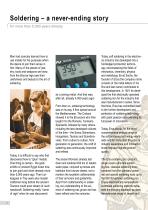
Man had scarcely learned how to use metals for his purposes when the desire to join them arose in him. Many of the pieces of jewelry, tools and weapons we know from the Bronze Age owe their usefulness and beauty to the art of soldering. Today, it is difficult to say who first discovered how to "glue" metals. One thing is certain - the goldsmiths of ancient Egypt knew how to join gold and silver already more than 5,000 years ago. Their colleagues in Troy were also master craftsmen long before the ancient Teutons could even dream of such handicraft. Soldering really "came of age" when tin was...
Open the catalog to page 2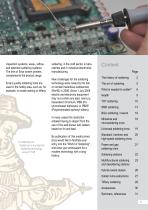
inspection systems, wave-, reflow-and selective soldering systems. The line of Ersa screen printers complements the product range. Ersa's quality soldering tools are used in the hobby area, such as, for example, in model-making or tiffany A soldering iron heated up in burning fire: Soldering technology around 1536 soldering, in the craft sector, in laboratories and in industrial electronics manufacturing. New challenges for the soldering technology were raised by the ban on certain hazardous substances (RoHS) in 2006. Since 1 July 2006 electric and electronic equipment may not contain any...
Open the catalog to page 3
Solder joints hold the world together{ Connecting pacemakers and solar parks To imagine today's world without soft soldering is not possible. It is the means to fabricate safely functioning, electrically conducting connections. Regardless of whether we talk about power technology, drive technology, telecommunications, automation or electronic controls - in all those fields soldered connections have a decisive share that everything functions in a way as has been foreseen and planned by the developers and visionaries of the products. Today, soft soldering is such a common place occurrence,...
Open the catalog to page 4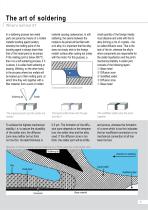
The art of soldering What’s behind it? In a soldering process two metal parts are joined by means of a molten metallic bonding agent (solder), whereby the melting point of the bonding agent is always lower than that of the metal parts to be joined. If the melting point is below 450 ºC, then it is a soft soldering process, if it is above, it is called hard soldering or brazing. Welding, on the other hand, is the process where two metals will be heated up to their melting point, at which time they will, together with a filler material, form a pool of molten material causing coalescence. In...
Open the catalog to page 5
What do you need for soldering? The basics – the 5 essential factors 1. The soldering iron to provide the heat required Heat is required to melt the solder. This is the soldering iron's job. Temperatures of 200 ºC – 450 ºC are required depending on solder joint and solder alloy. In the field of electronics, the usual temperature lies between 250 ºC and 375 ºC. In order to have the proper temperature for any soldering application, the soldering iron's thermal output and an efficient heat transfer to the solder joint to be made is decisive. One either selects a soldering iron that performs...
Open the catalog to page 6
2. The soldering tip to transfer the heat from the heating element to the tip The base material made of highly conductive electrolytic copper ensures unhindered heat transfer from the heating element to the ERSADUR LF coating Chrome-plating prevents corrosion and solder collection on undesirable spots ERSADUR LF coating (up to 600 micron) is factory pre-tinned with lead-free solder at working end Cross-section of an ERSADUR soldering tip, non-scale representation The soldering tip is the "heart" of the soldering iron and responsible for the heat transfer from the heating element via the...
Open the catalog to page 7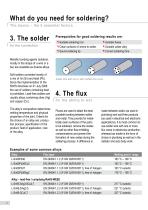
What do you need for soldering? The basics – the 5 essential factors Prerequisites for good soldering results are: Suitable soldering iron Suitable fluxes Clean surfaces of where to solder Suitable solder alloy Correct soldering time Metallic bonding agents (solders), mostly in the shape of a wire or a bar, are available as diverse alloys. Soft solders consisted mostly of a mix of tin (Sn) and lead (Pb). Since the implementation of the RoHS directives on 01 July 2006 the use of solders containing lead is prohibited. Lead-free solders are usually alloys containing silver (Ag) and copper...
Open the catalog to page 8
5. A safe and clean working environment to ensure quality and health Safety first, especially while soldering. The VDE and GS emblems ensure the electrical safety of soldering equipment. The use of the VDE sign obligates the manufacturer to monitor production accordance with test guidelines and to conduct tests according to the regulations determined by the VDE testing institute. Noxious gases develop in every soldering process Health protection during soldering The breathing zone is very close to the soldering process during manual soldering, and the solder is added by hand. Thus there is...
Open the catalog to page 9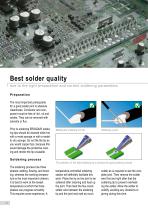
Best solder quality due to the right preparation and correct soldering parameters Preparation The most important prerequisite for a good solder joint is absolute cleanliness. Conductor and component must be free of dirt, oil and oxides. They can be removed with solvents or flux. Prior to soldering ERSADUR soldering tips should be cleaned while hot with a moist sponge or with a metallic dry sponge. Do not file the tip as you would copper tips, because this would damage the protective coating and render the tip unusable. Soldering process The soldering process has three phases: wetting,...
Open the catalog to page 10
Soldering time The soldering process should be completed within 2 to maximum 5 seconds with a correctly dimensioned soldering tip. When soldering electronic components with lead-free solders, experience Solder joint quality When the leads of the components mounted on the board are crimped, a good solder joint has been formed when the contour of the soldered lead is still visible. This will not be the case, if an excessive amount of solder has been used to form the joint. A further quality attribute is the wetting angle. This consideration is based on the fact that good wetting of the pad,...
Open the catalog to page 11All Ersa GmbH catalogs and technical brochures
-
Ersa wave soldering systems 2024
16 Pages
-
X-TOOL VARIO
2 Pages
-
SOLDERING TOOLS 2023/24
60 Pages
-
Ersa MOBILE SCOPE
2 Pages
-
REWORK- & INSPECTION SYSTEMS
44 Pages
-
Particle Foam Machines
17 Pages
-
Accessory Catalogue 2019
13 Pages
-
VERSASCAN & VERSAEYE
5 Pages
-
DISCOVER-SMART-TECHNOLOGIES
8 Pages
-
Ersa know-how transfer
2 Pages
-
Ersa Catalogue
52 Pages
-
Ersa VERSAPRINT 2
12 Pages
-
Ersa HOTFLOW 4 Series
16 Pages
-
Ersa HOTFLOW 3 Series
16 Pages
-
Ersa MULTI WAVE
16 Pages
-
Ersa VERSASCAN & VERSAEYE
8 Pages
-
Ersa SERVICES
12 Pages
-
Ersa Product Range
40 Pages
Archived catalogs
-
Ersa wave soldering systems
16 Pages
-
Ersa VERSAPRINT Stencil Printer
12 Pages
-
Ersa SMARTFLOW 2020
8 Pages
-
Ersa Festival of Innovations
8 Pages
-
SOLUTIONS 4YOU
6 Pages
-
Fine-Pitch Installation
1 Pages
-
Ersa CAD Assistant 3D
2 Pages















































